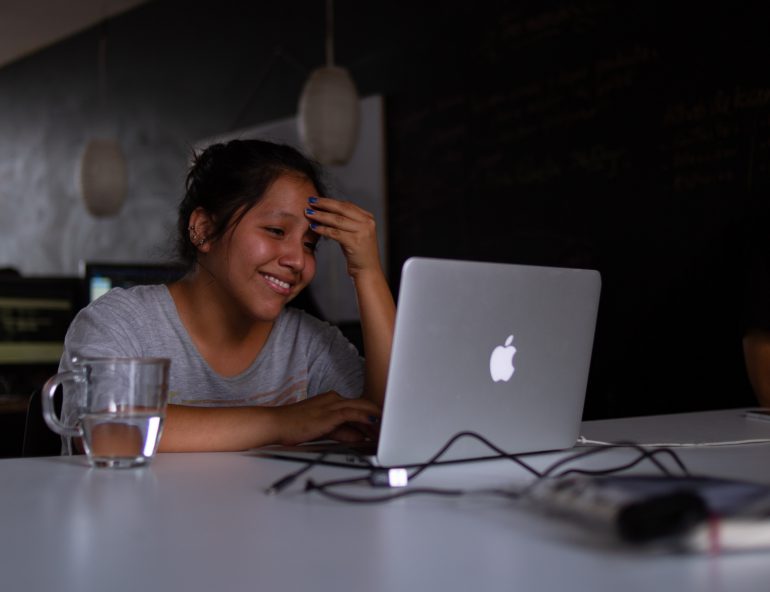Living through a global event in which we haven’t experienced the likes of before, there is no better time to highlight the fantastic and innovative work our colleagues are doing in their online classrooms. Since the University’s shift to online teaching on March 23, there have been different approaches to better utilise resources for student engagement and cohort building.
We spoke to Dr Benjamin Nickl from the School of Languages and Cultures on how he practically transformed class presentations to online video in one of his classes, ICLS1200 Language Hybrids and Cultural Fusions, a first-year unit that is a core unit in the SLC’s new Bachelor of Arts and Bachelor of Advanced Studies (Languages) (it is also part of the FASS first-year transition pilot program). Ben uses video as a form of summative and formative assessment, and as a feedback mechanism to students. The following interview captures responses to the questions we all ask, ‘how did you do it’?
I will continue using the mix of recorded and live presentations because I’m enjoying it a lot, and so are the students.
How do you ensure a collaborative, collegial environment online for your student cohort when it comes to presentations?
This semester, I’m delivering a first-year core unit in SLC’s new Bachelor of Arts and Bachelor of Advanced Studies (Languages). I noticed that at the beginning of the year, my students were anxious about the idea of presenting in class, so I decided to use recordings when we moved online. Public speaking anxiety is real, with first-years even more so. Imagine a screen full of Zoom boxes looking at you while you present on hybrid culture theories and language fusion models (live!) and then your housemates walk in or the connection drops out, or your mum shouts something at you from another room. I wanted everyone to have a fair go at producing the best work they could under the current circumstances, and something that they were proud of.
Before producing the video, they have to submit a written plan, which I mark. This gives them some initial feedback and guidance in shaping their videos. Students are then asked to record themselves presenting on their topic, for which they already have clearly laid out instructions. Each video is a maximum of ten minutes, and they have as many takes as they like. Students post the video recording the night before class, giving the other students time to watch the presentation before class.
They also post three discussion questions for the video that other students can respond to. They get assessed on the recording. Then the next day in class when we’re all live on Zoom, they can walk us all through their presentation and the questions—and honestly just have fun with it and don’t sweat the task. I try and break the ice by asking silly questions which eases the tension, such as ‘do you think this student utilised the lighting in the video the best they can?’ I do this because students are doing a fantastic job with their videos, and it doesn’t hurt to have a bit of levity right now!
You can always incorporate something funny in online class. It’s a good idea too, because it makes everyone feel at ease. Once a student of mine had to get up during class because their doorbell rang, and they received a parcel but had no idea what was in it. We all asked, ‘what’s in the parcel? Show us what you bought!’ to make them feel less awkward. Another one poured himself a cup from a vintage teapot when it was time to spill the ‘critical thinking’ tea. Online learning doesn’t have to be perfect, especially for first year students who can feel quite anxious. The prospect of ‘going live’ is hard. However, with video recordings, they get to practice as much as they like, and we can review their work formatively, which eases the pressure of performance for students.
It creates a better atmosphere that is more collaborative and focuses less on judgement of each other.
This is a positive shift, because with the previous requirements for ‘live’ presentations, I spent more time focussed on their ‘performance’, which meant that their learning did not come across as efficiently. As a teacher, I like the recorded online presentations because students try really hard, and I can focus on marking and helping them individually. They are also archived, so I can go back and review them which helps with assessment.
It’s very clear that students have fun with online videos as well, and I’m very happy with the quality of presentations. These presentations are assessments that capture students’ understanding at a point in time, and they can go back and review their own work later. I’m noticing that students are more engaged as a cohort. In class sometimes, they’d either be too nervous to concentrate, or they’d lose interest after they presented. It creates a better atmosphere that is more collaborative and focuses less on judgement of each other.
What has been the most challenging aspect with the transition to online presentations?
To be honest, I would say not much. The students are so used to this format, which comes across more organically online. Some find it very hard in their first year, standing up in class and nervously talking to their peers. This also allows them to confront their own learning processes and find out what works for them.
Some students may rarely speak up in class, but now I’m getting hundreds of words per student during these chats…
During live presentations in class, sometimes there are barely any questions from their peers. Silence, avoiding eye contact, all that stuff. It can feel like an awkward family dinner. With the shift to online, students use the chat feature throughout peer presentations. I summarise the key points of the presentation in the chat while students present, and the students discuss ideas and post their own questions. Some students may rarely speak up in class, but now I’m getting hundreds of words per student during these chats – some write paragraphs! The good thing is that I can save all this in a file and share with the students. It appears to be more fun for them, enabling banter and a bit of humour, which makes everyone feel comfortable.
Can you give three tips to a colleague who is hoping to implement something similar in their teaching practice?
- Be super clear with your instructions, and do not allow for ambiguity whatsoever. A step by step process is recommended.
- While online has worked well for most of my students, some students may experience a need to appear ‘perfect’ and feel pressure associated with their ‘online persona’. It’s important to tell them that the online teaching space differs to online public spaces; it’s not social media. It’s relatively safe, and can help them develop their ideas and confidence.
- You have to pick your fights online. If there’s something that is working well, utilise it. Transitioning online isn’t a perfect solution, but I will continue using the mix of recorded and live presentations because I’m enjoying it a lot, and so are the students.






1 Comment